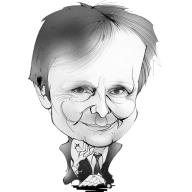George Gershwin once made a home movie of Arnold Schoenberg grinning in a suit on his tennis court in Beverly Hills but, sadly, never filmed one of their weekly matches. According to one observer, the composer of ‘I Got Rhythm’ played with languid strokes in a ‘nonchalant and chivalrous’ manner against the ‘choppy, over eager’ strokes of the creator of Erwartung.
That figures. But how odd that the two men should be friends and passionate admirers of each other’s work. Gershwin paid for the first recording of Schoenberg’s gnarliest string quartet, the Fourth; when the younger man died, Schoenberg described him as ‘a great composer’ and expressed ‘the deepest grief for the deplorable loss to music’. Few people would disagree – but it’s curious that Schoenberg, reliably mean-spirited about other composers, should be so drawn to Gershwin.
Trying to keep track of tone rows is a waste of time, as the conductor admitted
In his youth he had abandoned Judaism for Protestantism and declared that he was fighting for the hegemony of German culture over that of the ‘Latin and Slav’. He deplored tonal music for being riddled with ‘inbreeding and incest’. As Alex Ross notes in The Rest is Noise, this reveals a ‘weird undercurrent of racial pseudoscience’ and it’s not surprising that Schoenberg also loathed Weimar cabaret. By the time of his American exile he had returned to Judaism – a sincere decision motivated by horror at the Nazis. But he was also hanging out at George and Ira Gershwin’s parties; was there a touch of opportunism in his extravagant praise of George’s music?
I think the answer is no. It’s tempting to dismiss the opinions of a thin-skinned composer who sneered at Stravinsky and Bartok, but Schoenberg could recognise genius in popular music and, like Brahms, held Johann Strauss II in high esteem. On Sunday night, loudspeakers in the foyer of the Queen Elizabeth Hall played his chamber arrangements of Strauss as a prelude to a pre-concert discussion by Jonathan Cross, professor of musicology at Oxford; Professor Julie Brown, a Schoenberg specialist at Royal Holloway; and Jonathan Berman, who was about to conduct the London Sinfonietta in some heavy-duty Schoenberg including his Serenade Op. 24 and Ode to Napoleon Buonaparte. All three experts agreed that the ghost of a waltz can be heard even when the composer is being rigorously dodecaphonic.
The concert, which marked the 150th anniversary of Schoenberg’s birth, was entitled ‘Reshaping Tradition’, and that’s what we heard in the half-hour Serenade of 1923. It’s scored for seven instruments – clarinet, bass clarinet, guitar, mandolin, violin, viola and cello. The strumming of the mandolin is charming, but the most striking voice belongs to the clarinet. Mark van de Wiel flitted through a spectrum of colours with astounding dexterity, finding Viennese jauntiness in the most tortuous lines.
Of which there were plenty. The middle movement of the Serenade brings in a baritone for a Petrarch sonnet. Robert Craft’s programme notes explained the mathematics of the tone row: ‘The first note becomes the second, third, fourth and fifth, for the reason that Petrarch’s 11-syllable line leaves a leftover note in each repetition of the series.’ Alas, I didn’t read that until later – and of course kicked myself for not noticing.
Just kidding. Trying to keep track of tone rows is a waste of time, as Berman admitted in his pre-concert reflections. At its best, Schoenberg’s system for abolishing tonality produces a liberating weightlessness. But less is more, and if you’re going to write a 12-tone suite inspired by the baroque then you need to stick to the most modest baroque dimensions. The Serenade doesn’t. After 15 minutes I’d had enough of unyielding diaphanous ingenuity.
I’m not sure the London Sinfonietta did Schoenberg any favours with its radiant performance of his pupil Anton Webern’s Symphony (1928) in the second half. Although its formal scheme is even more intimidating than that of the Schoenberg Serenade – impossible to grasp unless you’re following the score – its palate-cleaning pointillism illustrates why, nearly 80 years after he was accidentally shot dead by an American soldier, Webern is more revered than his master. Also, the whole thing lasts only ten minutes.
Yet Schoenberg will always be the more historically significant figure. Why? Professor Brown offered a novel suggestion on Sunday. Although concert audiences still run a mile from the atonalism that he basically invented, you can’t watch a police procedural on television without encountering a version of it when the drama requires tension or terror.
That’s a nice point, and one that triggered a surreal train of thought during the longueurs of the concert. What about a detective series set in a dystopia run by the Second Viennese School? A smirking DCI Adorno slaps down a manuscript in front of a quivering composer. ‘You faked the transposition of the tone row in the inverted canon. Did you think we wouldn’t notice?’ And snap go the handcuffs.








Comments